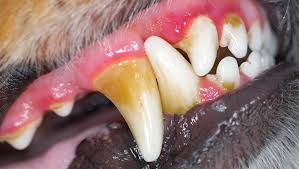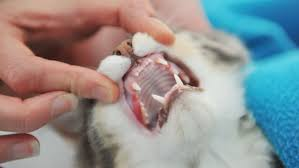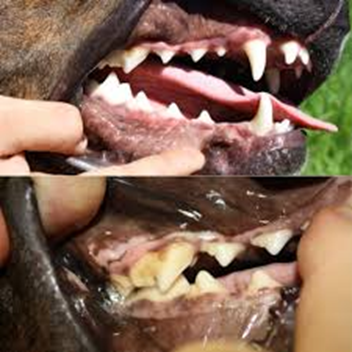Dental Disease
DOES YOUR PET HAVE DENTAL DISEASE?
Does your dog or cat have bad breath, red or swollen gums, yellow/brown or loose/missing teeth, reduced appetite or is losing weight? If the answer is yes your pet may be suffering from periodontal disease!......
Periodontal disease is the most common clinical condition diagnosed by vets and occurs both in adult dogs and cats and is often entirely preventable.
Periodontal disease is a bacterial infection of the mouth and involves four stages including:
By three years of age 80% of dogs and cats have some evidence of periodontal disease. Unfortunately, other than bad breath, there are few signs of the disease process that are evident! As a result, periodontal disease is often missed by owners and may cause multiple problems in the oral cavity associated with damage to internal organs in some pets as they age.
Signs of Peridontal Disease:
Periodontal disease develops as a result of bacteria and plaque under the gum line. Plaque mixes with minerals in the saliva and hardens into tartar which is firmly adhered to the tooth. If the tartar isn’t removed, it will build up under the gums, eventually causing them to pull away from the teeth. This creates small pockets in the gum tissue which become pockets for bacteria. This bacteria then releases toxins which causes your pet to have bad smelling breath and infection resulting in painful and inflamed gums, loose teeth, weight loss and serious illness.
If periodontal disease is left unchecked it progresses and becomes increasingly painful. How quickly this process takes place in your pet’s mouth depends on a number of factors, including age, overall health, diet, breed and genetics.
Periodontal disease is commonly associated with poor diet and if your dog or cat eats predominantly wet food then this can predispose them to developing dental disease. Some other conditions which may lead to periodontal disease include:
Malocclusion
Malocclusion is the term used when one or more teeth are not properly positioned. Selective breeding has resulted in malocclusions being “normal” for some breeds (e.g. Boxers, Bulldogs, Pugs, Shih Tzus, etc.) due to shortening of the upper jaw (maxilla).
Retained Deciduous Teeth
Just like in people, our pets have deciduous (“baby”) teeth. These teeth stay in the mouth until 4-6 months of age when the adult teeth should erupt pushing the deciduous teeth out. This process does not proceed correctly in some pets which results in the deciduous tooth being retained in the mouth. Retained deciduous teeth cause problems by causing plaque accumulation and impeding the eruption of the adult tooth. All pets should be checked by a veterinarian for retained deciduous teeth between 5-6 months of age. If retained deciduous teeth are identified they should be extracted promptly.
Feline Gingivostomatitis
Stomatitis or gingivostomatitis is another common disease affecting primarily cats. This is a painful condition which involves severe inflammation of the oral soft tissues. It appears that stomatitis results from the cat’s immune system reacting to the plaque film on the teeth.
Broken Teeth
Teeth may break for a variety of reasons including: trauma, aggressive chewing and decay. Any tooth with signs of wear or fracture should be evaluated promptly. Broken teeth can result in pain and predispose teeth to developing infection which can result in the tooth becoming non-vital. The earlier treatment is initiated after a fracture, the better for the pet.
Masses / Oral Tumors
Any time a growth or abnormal tissue is noted in a pet’s mouth investigation is warranted. Sometimes masses or growths are only found during the detailed examination under anesthesia during a veterinary check up. Pets can have a variety of oral growths which can be either benign (non-cancerous) or malignant (cancerous).
Preventing Dental disease in your Pet
Signs of periodontal can be subtle in pets and often go unnoticed by owners. However the good news is that with a good diet, consistent home dental care and regular veterinary check ups, periodontal disease can be slowed or even prevented!
Diet
The texture of food and its composition can affect the environment of the mouth. It can help maintain tissue integrity, stimulate saliva production, alter plaque bacteria metabolism and provide mechanical cleansing of tooth surfaces. Feeding a good quality dry dog food is preferable to feeding a wet food as the mechanical action and abrasion on the surface of the tooth when the dog bites into a hard food will help prevent the formation of plaque and bacteria on the tooth surface. Feeding raw bones in addition to good quality dental chews and treats is also a good way to prevent and/or minimise periodontal disease in your pet.
Home dental care: toothbrushing
Brush your pet’s teeth, preferably every day. If every day is too tall an order, commit to do it several times a week. If you’ve never tried brushing those canine or feline choppers -- or you’re not having much luck when you try -- view these instructional videos on how to brush your cat’s or dog’s teeth. A little time, patience and persistence can reap tremendous rewards in terms of your pet’s well-being and healthcare costs.
Regular routine mouth inspections
Perform routine mouth inspections. Your pet should allow you to open his mouth, look inside, and feel around for loose teeth or unusual lumps or bumps on the tongue, under the tongue, along the gum line and on the roof of his mouth. After you do this a few times, you’ll become sensitive to any changes that might occur from one inspection to the next. You should also make note of any differences in the smell of your pet’s breath that aren’t diet-related.
Regular Veterinary Check ups
Arrange for regular oral exams performed by your veterinarian. He or she will alert you to any existing or potential problems in your pet’s mouth, and recommend professional teeth cleaning under anaesthesia, if necessary. Once plaque has formed on the surface of teeth it cannot be removed with teeth brushing and a scale and polish performed by a veterinarian under a general anaesthesia may be required. However once the teeth have been cleaned regular tooth brushing, diet and regular veterinary health checks are important in order to prevent reoccurrence of dental disease and further dental problems in the future.
Before and after a dental scale and polish:













